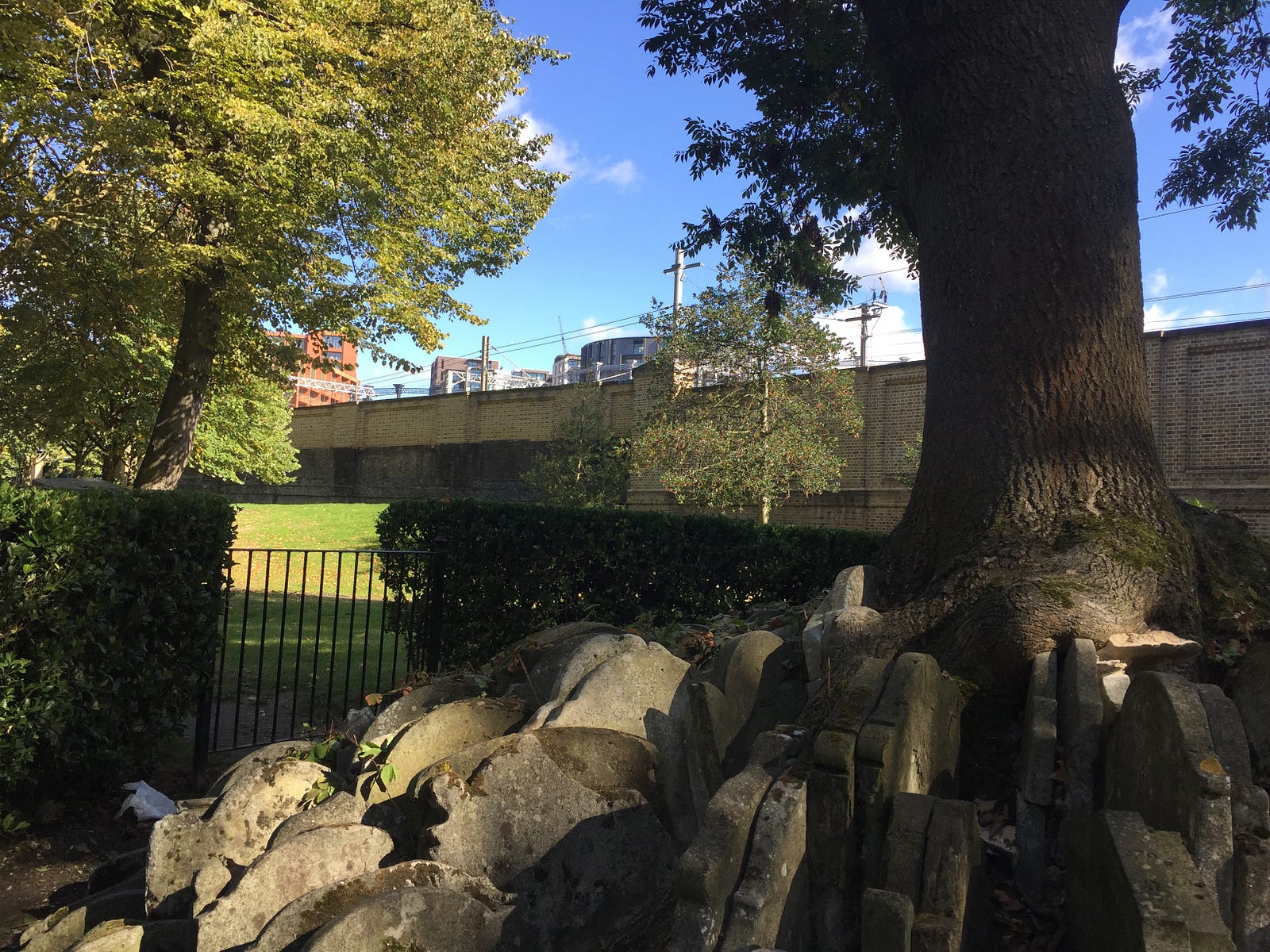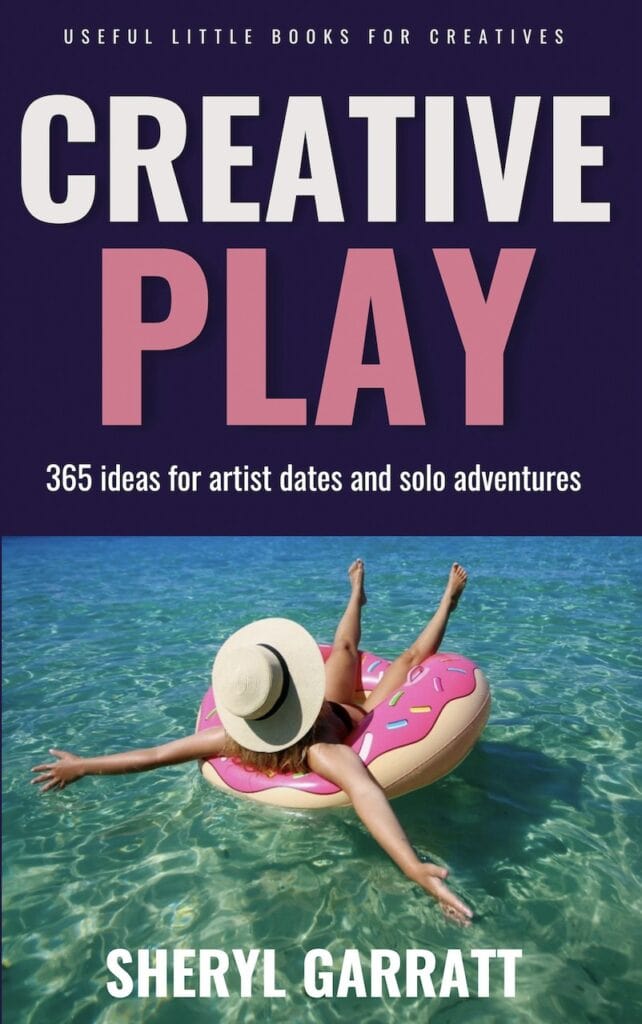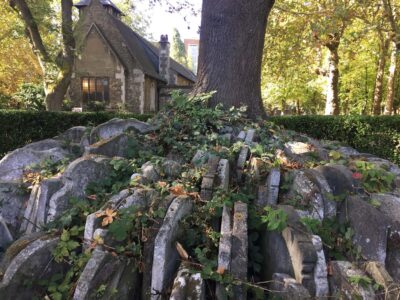When did you last spend some quality time with you?
For my artist’s date this week, I’ve decided to get an earlier train up to London. Later, I’m meeting up with a coaching client at the offices of her record label, but before then I’m on a mission of my own. So at St Pancras station, instead of following the other passengers down from my train platform into the Underground, I walk out and along the road to Old St Pancras Church.
I lived just a couple of miles from here for more than 20 years, and I have passed through the station hundreds of times since moving out of the capital to the Kent coast. Yet I’ve never been into this shady, tree-lined churchyard.
In another city, this kind of place would be known and celebrated. But London is heavy with history. Roman walls jostle with glass-and-steel office buildings, rivers are buried and forgotten under roads. Even the trees are old and venerable, and the city brims with small, secret green spaces like this churchyard, squeezed between a busy road and the high-speed rail lines which now lead down into the Channel Tunnel and on to France.
It’s a peaceful place.
The leaves are starting to turn on the plane trees, and the sun is slanting through their yellow canopies. Here, the persistent hum of London traffic seems muffled, augmented by the odd siren, and the rattle of trains leaving the station above. On the other side of the tracks, a whole new quarter of London has gradually risen from neglected industrial land, with shiny new apartment and office buildings, and open spaces thronged with art and design students from the recently transplanted St Martins college. But in the churchyard, time feels as if it’s has somehow been paused.
Passing by the architect Sir John Sloane’s elaborate memorial to his wife, I find a much smaller stone memorial covered in poems, messages and tributes in in the suffragette colours of purple, green and white. It turns out to be the grave of the 18th century writer, adventurer, and early advocate of women’s rights, Mary Wollstonecraft.
She died near here, at the age of just 38, eleven days after giving birth to her brilliant daughter, Mary. (Who later, under her married name of Mary Shelley, was to write Frankenstein.) All of this is a pleasant surprise.
But what I really came to see is a tree.
First, some history. St Pancras station was built in the 1860s, a grand new terminus with an imposing Gothic red-brick façade designed by Sir George Gilbert Scott. On an awkward site constrained by the Regents Canal on one side, the Metropolitan underground line underneath it and the biggest burial ground in north London behind it, the new station was designed with raised platforms high above ground level and rail tracks that swept straight out over much of the graveyard.
Arthur Blomfield was the architect commissioned by the Bishop of London to dismantle the tombs and exhume the human remains to make way for these new tracks, a task he in turn delegated to a young trainee, Thomas Hardy. The young man supervised the work carefully, arranging some of the smaller headstones in the much-diminished churchyard in circles around a young ash tree.
But his heart wasn’t drawn to the life of an architect. So in 1867, he left Blomfield’s office to concentrate on writing. His experience in St Pancras obviously affected him deeply, and he later wrote about it in his poem, The Levelled Churchyard.
O Passenger, pray list and catch Our sighs and piteous groans Half stifled in this jumbled patch Of wrenched memorial stones! We late-lamented, resting here, Are mixed to human jam, And each to each exclaims in fear. ‘I know not which I am!’
Thomas Hardy became a great novelist.
While he was writing his books, and generations read and loved them, the ash tree — now known as the Hardy tree — remained in its place near the train tracks.
Its roots have gradually grown up and around the bramble-covered gravestones, which rise out from its base like worn, grey old teeth.
It was magical, and I was glad I’d taken an hour out of a busy day to go see it. Walking back under the train tracks and into the bustle of 21st century London, I felt rested, inspired, ready to work. Which is the whole point of my weekly Artist’s Date.
It’s moments like these that fuel us, creatively.
It’s easy to spend days, weeks, months staring at a screen, working in our office or studio, meeting deadlines and running chores, without ever taking time out to just look at something interesting, inspiring, or new. Without taking time out to do something simply because it makes us laugh, or it brings us joy.
Once a week, I choose to give myself at least an hour to do something like my walk to see the Hardy tree. Something with no point except to satisfy curiosity, or feed the soul. In. her book The Artist’s Way, Julia Cameron calls it an Artist’s Date. Others call it a Play Date. The important thing is that it is you, spending some pre-planned time with you.
What can you do on an artist’s date?
Sometimes it can be as simple as having a long soak in the bath, sitting in a coffee shop with a good book, taking a walk or a class, or going to the cinema alone in the middle of the afternoon.
Perhaps you could finally use those old paints or craft materials sitting in a drawer. You might wander through a new market, or rummage through a charity shop. You could also sometimes be more adventurous, or indulgent.
I’ve had a client who went to the circus. And was then inspired to take a trapeze lesson. Others have enjoyed lessons in archery, sword fighting, Arabic and bread-making. They’ve been trampolining, go-kart racing, belly dancing. They’ve been to lunchtime concerts, theatre matinees, or sat in on random lectures. One went to the National Gallery in London for several weeks running, and chose a painting. Then sat looking at it, intensely, for the whole hour.
The clients who resist the idea most tend to be those who are already over-stretched, stressed, teetering on exhaustion, feeling that they no longer know what they want in life. The weekly date helps them reconnect with their true selves, to gradually learn to unwind and have fun again.
The busier you are, the more important the date is. When you value yourself enough to take at least an hour a week to explore, to play, to do something for no reason except wanting to do it, you’ll find you get more done, with less stress. You’ll also start to realise what is really important, rather than filling your days with busy-work.

Some questions, for beginners.
- What makes you smile?
- What did you love doing as a child?
- Is there a career, an alternative life you sometimes wish you’d led?
- Is there a hobby you’ve abandoned?
- A different exercise class you’d like to try?
- Is there something that feels impossibly decadent, daring or ridiculous?
- And could you try it, if only in a small way?
It needn’t cost the earth. Be creative!
“I want to go to Paris, but I can’t afford it!” a client says.
So we talk about what she really wanted from Paris, and how she might get a taste of that on her Artist’s Date, without actually going there. She might decide to watch a French film, or go out for coffee and a croissant. She might sit sketching or writing in the park, or dress up like a chic, pulled-together Parisienne for the day. Perhaps she just dusts off those teach-yourself-French CDs and begins with them again.
In the end, this particular client realised that what she really wanted was the freedom she’d felt in Paris, to wander streets at random, simply watching and thinking and daydreaming. So that’s what she did, in her home city.
There are some rules.
It’s important to plan your artist’s date in advance, and go on it alone, not with family or friends. This is about you spending quality time with you.
The point is that you see this as a scheduled part of your weekly routine, and start looking out for activities and mini-adventures to try.
And when you do, magic happens.
You get an idea for a new art series at a funfair. You get chatting to a woman looking round a fabric shop, and make a new friend. A one-off tai chi class turns into a practice for life. That painting at the gallery, and the girl staring intently at it, inspires a new song, or a story. You get a business idea. Or get chatting to a stranger who turns out to have exactly the contacts you need. The answer to a problem you’ve been mulling just pops into your head, while you’re doing something completely different.
Or maybe you just start laughing more, sleeping better, and trying new things. And your life opens up with new possibilities.
Try it for a few weeks, see what it does for you.
A book to help you play more (and work better)

Making time to play, explore, try new things without needing it to yield an immediate result is a key part of any creative practice.
When you’re self-employed or on a deadline, it can also be the part you neglect!
This short, practical book explains why you might need to bring more play into your life and work – with 365 ideas to start you off.
This is for you if:
- Your creative work is feeling grey, uninspired, heavy and difficult.
- You’ve read Julia Cameron’s book The Artist’s Way but never found time for the Artist Dates (or you couldn’t think what to do).
- You want to bring more playfulness into your life.
- You’ve lost touch with your creativity and you want to come back to it.
- It’s been a long, long time since you’ve given yourself a break.
It will help you get into flow more easily, step back and see what’s important, feel more inspired and alive – and just have more fun!
Available now from Amazon, at £8.99 (paperback) or £5.99 (Kindle). I appreciate that not everyone wants to use Amazon, so you can also buy the e-book directly from me if you’d prefer.






[…] Learn how to play again. Not how to play your instrument, but how to have fun with it. Go on artist dates. Use Morning Pages. Deliberately do something different. Change your routine, your environment, […]